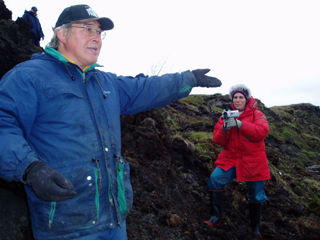Pairing Scientific and Traditional Knowledge
Scientists have access to powerful instruments such as satellite technology that provides aerial views of the Arctic. Indigenous people have daily hands-on experience in the Arctic, and tap into traditional knowledge, passed down for centuries. With climate change a pressing issue for both parties, partnerships that pair scientists with indigenous people are happening more frequently, and are collectively creating a better understanding of the Arctic.
Many partnerships have already formed, or are forming. Some are practical—such as pairing indigenous guides who understand polar bear behavior with scientists who need bear protection. Some are more profound. For archeologist/anthropologist Anne Jensen, who often collaborates with Iñupiaq Elders, Iñupiaq people often fill in the gaps in research. In 1994, for example, the body of a young girl from about A.D. 1200 surfaced on a bluff near Barrow. Jensen was called to examine it and discovered that the girl had been buried with some pieces of skin. The Iñupiaq Elders were able to identify the skin as part of a kayak cover by looking at its shape and its stitches, drawing on their traditional knowledge.

In Canada’s Ashkui Project, Environment Canada scientists collaborate with Innu Elders to gain understanding of the area’s ecology. Here, both parties discuss the results of water chemistry tests.
Increasingly, there are more formal partnerships between researchers and indigenous people as well. For example, geographer Shari Gearheard is heading a three-year National Science Foundation–funded project in which scientists and Inuits in Canada, Greenland, and Alaska form a research team to study sea ice. According to Gearheard, scientists know relatively little about the small-scale and regional processes and changes in the sea ice, while the Inuit have a very detailed knowledge of sea ice at the fine scale. “This is useful for scientists, who study sea ice mainly from satellite imagery, so they have complimentary perspectives,” she notes.

Shari Gearheard with Ilkoo Angutikjuak, Inuit Elder and hunter from Clyde River, Nunavut, with whom she has worked closely since 2000 on environmental change research.
These partnerships are not without problems, however. For example, scientific data and indigenous knowledge can conflict, and collaborations have raised the issue of indigenous knowledge as intellectual property. Also, it’s not always easy for indigenous people to trust scientists; they’ve been burned in the past. As scientist Glenn Sheehan notes, “Local people that I know were treated with radioactive iodine in a “zany” experiment to see if it would affect their susceptibility to cold. These people did not speak English at the time, and they were not told what was happening; in fact, they were given lies. Now when some of them get cancer they are convinced, perhaps rightly, that it was scientists who did this to them.”
Despite these issues and obvious past abuse, the collaborations between scientists and indigenous people are increasing, providing a more complete picture of the Arctic and climate change than either perspective could offer alone.











